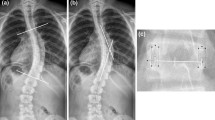Summary
The measurement of vertebral rotation according to Perdriolle is widely used in the French-speaking and Anglo-American countries. Even in this measurement technique there may be a relatively high estimation error because of the not very accurate grading in steps of 5°. The measurement according to Raimondi seems to be easier to use and is more accurate, with 2° steps. The purpose of our study was to determine the technical error of both measuring methods. The apex vertebra of 40 curves on 20 anteroposterior (AP) radiographs were measured by using the Perdriolle torsion meter and the Regolo Raimondi. Interrater and intrarater reliability were computed. The thoracic Cobb angle was 43°, the lumbar Cobb angle 36°. The average rotation according to Perdriolle was 19.1° thoracic (SD 11.14), 12.7° lumbar (11.21). Measurement of vertebral rotation according to Raimondi showed an average rotation of 20.25° in the thoracic region (11.40) and 13.4° lumbar (10.92). The intrarater reliability was r=0.991 (Perdriolle) and r=0.997 (Raimondi). The average intrarater error was 1.025° in the Perdriolle measurement and 0.4° in the Raimondi measurement. Interrater error was on average 3.112° for the Perdriolle measurement and 3.630° for the Raimondi measurement. This shows that both methods are useful tools for the follow-up of vertebral rotation as projected on standard X-rays for the experienced clinicial. The Raimondi ruler is easier to use and is slightly more reliable.
Similar content being viewed by others
References
Aaro S, Dahlborn M (1981) Estimation of vertebral rotation and the spinal and rib cage deformity in scoliosis by computer tomography. Spine 6:461–467
Adams W (1865) Lectures on the pathology and treatment of lateral and other forms of curvature of the spine. Churchill and Sons, London
Barsanti CM, deBari A, Covino BM (1990) The torsion meter: a critical review. J Pediatr Orthop 10:527–531
Benson DR, Schultz AB, DeWald RL (1976) Roentgenographic evaluation of vertebral rotation. J Bone Joint Surg [Am] 58:1125–1129
Cobb JR (1948) Outline for the study of scoliosis (AOS Instructional Course Lectures, 5) American Academy of Orthopaedic Surgeons, Ann Arbor, pp 261–275
Dangerfield PH, Scutt D, Dorgan JC, Li Y, Pearson JD, Brodie DA (1992) The effect of body position on the three-dimensional surface deformity of scoliosis. Proceedings of the International Symposium on 3-D Scoliotic Deformities joined with the VIIth International Symposium on Spinal Deformity and Surface Topography, Montreal, Canada, June 1992. Editions de l'Ecole Polytechnique de Montréal, Gustav Fischer Verlag, pp 139–147
Drerup B (1984) Principles of measurement of vertebral rotation from frontal projections of the pedicles. J Biomechan 17:923–935
Drerup B (1985) Improvements in measuring vertebral rotation from the projections of the pedicles. J Biomechan 18:369–378
Hallbauer T, Deimling U von, Schumpe G, Schmitt O (1992) Röntgenologische Aspekte der Skoliosediagnostik. Presented at the 41 st annual meeting of the Norddeutsche Orthopädenvereinigung, Cologne, Germany, June 28
Ho EKW, Upadhyay SS, Ferris L, Bacon-Shone J, Chan FL, Hsu LCS, Leong JCY (1992) A comparative study of computed tomographic and plain radiographic methods to measure vertebral rotation in adolescent idiopathic. Spine 17:771–774
Marchesi DG, Transfeldt EE, Bradford DS, Heithoff KB (1992) Changes in vertebral rotation after Harrington and Luque instrumentation for idiopathic scoliosis. Spine 17:775–780
Nash CL, Moe JH (1969) A study of vertebral rotation. J Bone Joint Surg [Am] 51:223–229
Perdriolle R (1991) Letter to the editor. J Pediatr Orthop 11:789
Perdriolle R, Vidal J (1985) Thoracic idiopathic scoliosis curve evolution and prognosis. Spine 9:785–791
Richards SB (1992) Measurement error in assessment of vertebral rotation using the Perdriolle torsion meter. Spine 17:513–517
Skalli W, La Vaste F, DesCrimes JL (1993) Quantification of 3D vertebral rotations in scoliosis: what are the true values? Proceedings of the Scoliosis Research Society meeting, Dublin, pp 200–201
Vaysse C, Neiger H, Bruandet JM (1991) Psoas et rotation vertébrale dans la scoliose lombaire. In: Ducortgé P (ed) Vingts années de recherches et d'expérimentation. Montpellier, Sauramps Médical, pp 97–104
Weiss HR (1992) Die Messung der Wirbeltorsion mit dem ‘Regolo Raimondi’ Presented at the 41 st annual meeting of the Norddeutsche Orthopädenvereinigung, Cologne, Germany, June 29
Author information
Authors and Affiliations
Rights and permissions
About this article
Cite this article
Weiss, HR. Measurement of vertebral rotation: Perdriolle versus Raimondi. Eur Spine J 4, 34–38 (1995). https://doi.org/10.1007/BF00298416
Received:
Revised:
Accepted:
Issue Date:
DOI: https://doi.org/10.1007/BF00298416




